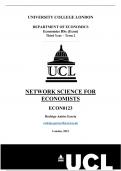Summary
ECON0123 (Network Science for Economists) Summary - UCL Economics BSc Third Year
- Course
- Institution
Summary of Network Science for Economists taught in ECON0123 (Year 2022/2023) Detailed notes from lecture notes, textbooks and other materials. Topics covered include: 1) Overview and Basics of Graph Theory, 2) Optimization on Network and Congestion Games, 3) Auctions and Sponsored Search Auc...
[Show more]





